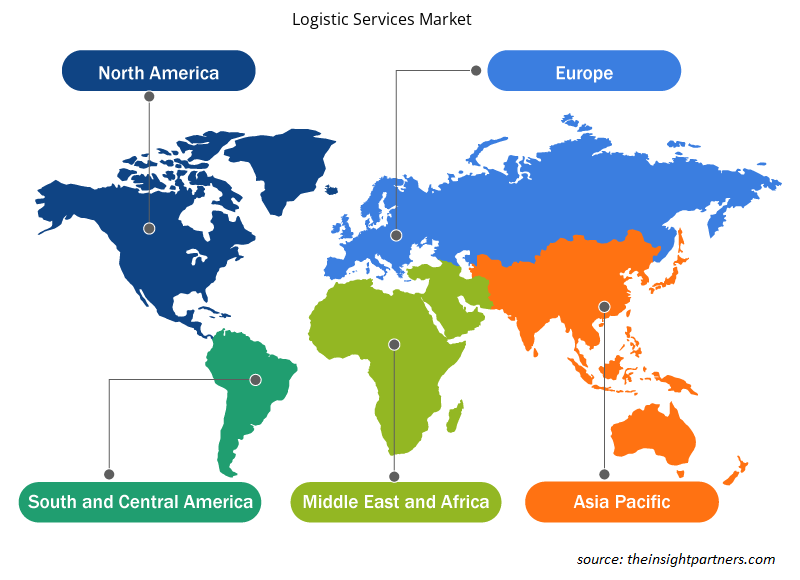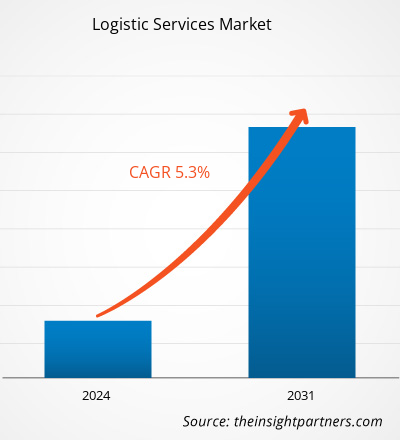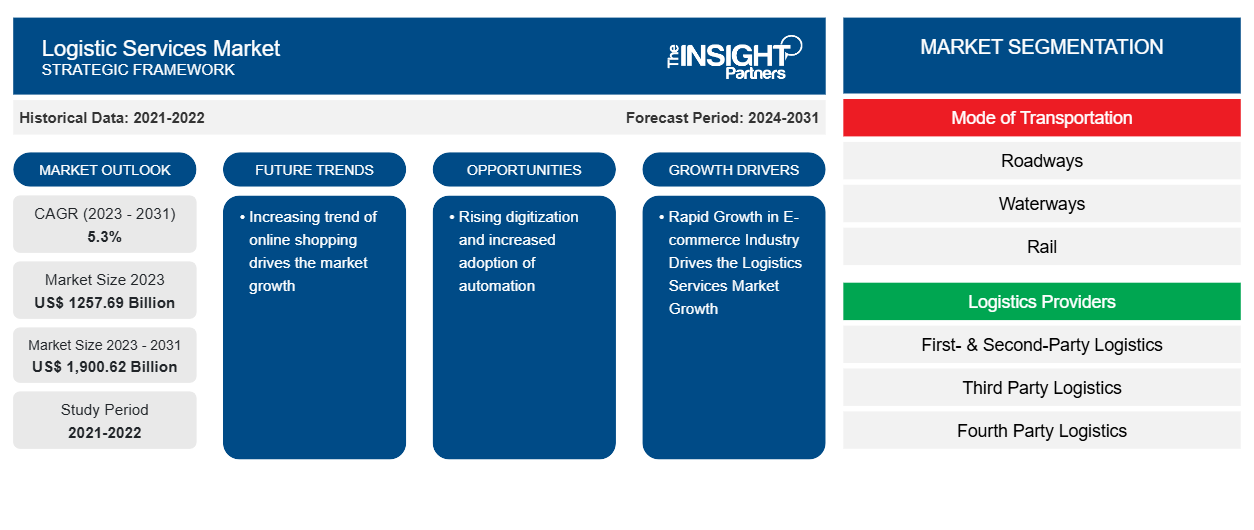预计到 2031 年,物流服务市场规模将从 2023 年的 12576.9 亿美元增至 19006.2 亿美元。预计 2023-2031 年市场复合年增长率将达到 5.3%。对外包物流服务业务的需求不断增长,供应链流程得到改进,以降低运营成本,这为物流服务市场的增长创造了巨大的需求。此外,第三方物流和第四方物流供应商的日益普及也推动了全球对物流服务市场的需求。目前,领先的物流供应商包括货运代理、货运管理公司、物流咨询公司、库存和仓储管理服务提供商、供应链咨询公司等。
此外,物流公司越来越多地采用基于先进技术的远程信息处理解决方案,这也推动了市场的增长。物流服务提供实时跟踪、包裹跟踪和监控以及仓库规划等多种操作,预计将推动物流服务市场的增长。由于电子商务行业的快速发展,全球物流服务市场高度分散。
物流服务市场分析
物流服务包括第一方和第二方物流供应商、第三方物流 (3PL)、第四方物流和第五方物流。物流服务是供应链管理的重要组成部分。第四方物流服务将产品交付给最终客户并增加利润率。物流服务包括供应链的所有要素,从工厂到最终消费者的货物交付。它们包括将货物从制造商运输到仓库、从仓库运输到分销商、客户订单履行和交付给最终用户。3PL 促进所有物流服务作为订单履行的一部分。物流服务包括从工厂到履行仓库的运输、仓储订单履行、出站运输以及从客户到客户的订单交付。
物流服务市场概况
物流服务运输包括航空、铁路、水路和公路运输。其中,公路运输在 2023 年占有最大份额,这是由于电子商务行业在全球范围内的快速采用。此外,水路运输涉及通过河流、湖泊、运河和沿海水域运输货物和乘客。水运对于长距离运输大量货物具有成本效益,并且与公路和航空相比具有较高的运载能力。全球化工业化的快速增长以及全球进出口活动的激增是预测期内物流服务市场增长的主要驱动因素。这些因素正在推动预测期内物流服务市场的增长。
定制此报告以满足您的需求
您可以免费定制任何报告,包括本报告的部分内容、国家级分析、Excel 数据包,以及为初创企业和大学提供优惠和折扣
- 获取此报告的关键市场趋势。这个免费样品将包括数据分析,从市场趋势到估计和预测。
物流服务市场驱动因素和机遇
电子商务行业快速增长推动物流服务市场增长
电子商务行业主要依靠物流服务来管理向最终客户的货物交付。全球对在线购物的需求增加,以及全球互联网普及率的激增,是预测期内物流服务市场增长的主要驱动因素。2023 年,美国电子商务行业销售额达到约 1.119 万亿美元,比 2022 年的 1.03 万亿美元增长 7.6%。与此同时,零售电子商务销售额在 2023 年达到 5.088 万亿美元,比 2022 年的 4.904 万亿美元增长 3.8%。由于全球电子商务消费者数量的不断增长,电子商务行业的快速增长推动了预测期内物流服务市场的增长。随着电子商务行业的不断扩张,对最后一英里交付物流服务的需求也在增加。推动物流服务市场增长的主要行业包括零售、制药、食品和饮料。此外,预测期内,快速消费品行业的产品也对物流服务市场的增长做出了巨大贡献。
数字化程度不断提高,自动化程度不断提高
物流部门负责管理制造业的供应链。它涉及货物、服务和相关产品的运输。随着数字化和自动化的快速应用,物流行业的需求量巨大。物流服务提供商越来越多地采用人工智能、物联网 (IoT)、机器学习和机器人等技术来简化物流操作并提高运输效率。这包括仓库自动化、机器人实施、预测分析、自动驾驶汽车等。
物流服务市场报告细分分析
有助于得出物流服务市场分析的关键部分是类型、平台、应用程序和最终用户。
- 根据运输方式,全球物流服务市场分为公路运输、水路运输、铁路运输和航空运输。
- 根据物流提供商,市场分为第一方和第二方物流、第三方物流、第四方物流和第五方物流。
- 根据最终用户,全球物流服务市场分为政府和公共事业、医疗保健、工业制造、零售和消费品、航空航天和国防等。
按地区划分的物流服务市场份额分析
物流服务市场报告的地理范围主要分为五个地区:北美、欧洲、亚太、中东和非洲、南美。
预计北美物流服务市场将占据最大份额,并且在预测期内正在快速增长。由于电子商务行业的增长,物流服务行业正在快速增长。美国和加拿大等国家拥有大量主要物流服务提供商,包括 UPS、FedEx、DHL 和 CH Robinson。由于《美国-墨西哥-加拿大协议》(USMCA)促进了贸易活动的活跃,该地区获得了大量需求。此外,该地区还拥有多种先进技术,例如人工智能、大数据、云计算和物联网。
物流服务市场区域洞察
Insight Partners 的分析师已详细解释了预测期内影响物流服务市场的区域趋势和因素。本节还讨论了北美、欧洲、亚太地区、中东和非洲以及南美和中美洲的物流服务市场细分和地理位置。

- 获取物流服务市场的区域特定数据
物流服务市场报告范围
| 报告属性 | 细节 |
|---|---|
| 2023 年的市场规模 | 12576.9亿美元 |
| 2031 年市场规模 | 19006.2亿美元 |
| 全球复合年增长率(2023 - 2031) | 5.3% |
| 史料 | 2021-2022 |
| 预测期 | 2024-2031 |
| 涵盖的领域 | 按交通方式
|
| 覆盖地区和国家 | 北美
|
| 市场领导者和主要公司简介 |
|
物流服务市场参与者密度:了解其对业务动态的影响
物流服务市场正在快速增长,这得益于终端用户需求的不断增长,而这些需求又源于消费者偏好的不断变化、技术进步以及对产品优势的认识不断提高等因素。随着需求的增加,企业正在扩大其产品范围,进行创新以满足消费者的需求,并利用新兴趋势,从而进一步推动市场增长。
市场参与者密度是指在特定市场或行业内运营的企业或公司的分布情况。它表明在给定市场空间中,相对于其规模或总市场价值,有多少竞争对手(市场参与者)存在。
在物流服务市场运营的主要公司有:
- 罗宾逊
- 德铁信克物流
- 联合包裹服务公司
- Expeditors 国际公司
- 乔达物流
- 日本通运
免责声明:上面列出的公司没有按照任何特定顺序排列。

- 了解物流服务市场顶级关键参与者概况
物流服务市场新闻及最新发展
物流服务市场通过收集一手和二手研究后的定性和定量数据进行评估,其中包括重要的公司出版物、协会数据和数据库。以下是物流服务市场的发展和战略列表:
- 2023 年 1 月,亚马逊公司在印度推出了航空货运机队服务 Amazon Air。这项服务是为了满足电子商务行业日益增长的需求而推出的。这家电子商务公司与 Quikjet India 位于班加罗尔市的航空货运服务提供商公司合作,旨在加快包裹递送速度。(来源:DJI,新闻稿/公司网站/时事通讯)
- 2023 年 3 月,物流公司 AP Moller-Merks 开通了丹麦比隆和中国杭州之间的空运服务。这项新物流服务的推出是为了满足日益增长的客户需求。(来源:Flyability,新闻稿/公司网站/时事通讯)
物流服务市场报告范围和交付成果
“物流服务市场规模和预测(2021-2031)”报告对市场进行了详细的分析,涵盖以下领域:
- 范围内所有主要细分市场的全球、区域和国家层面的市场规模和预测
- 市场动态,如驱动因素、限制因素和关键机遇
- 未来主要趋势
- 详细的PEST分析
- 全球和区域市场分析涵盖关键市场趋势、主要参与者、法规和最新市场发展
- 行业格局和竞争分析,涵盖市场集中度、热点图分析、知名参与者和最新发展
- 带有 SWOT 分析的详细公司简介
- 历史分析(2 年)、基准年、预测(7 年)及复合年增长率
- PEST和SWOT分析
- 市场规模、价值/数量 - 全球、区域、国家
- 行业和竞争格局
- Excel 数据集
近期报告
相关报告
客户评价
购买理由
- 明智的决策
- 了解市场动态
- 竞争分析
- 客户洞察
- 市场预测
- 风险规避
- 战略规划
- 投资论证
- 识别新兴市场
- 优化营销策略
- 提升运营效率
- 顺应监管趋势





















 获取免费样品 - 物流服务市场
获取免费样品 - 物流服务市场